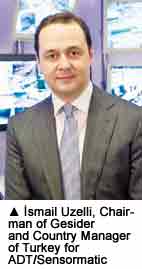2009 has born witness to countless struggles in a subdued global economy. Collateral damages can be seen in every industry, with some governments forced to put projects on hold while others pressed on with stimulus packages. A&S reviews the year's happenings and presents how industry players have prepared for 2010.
2009 has born witness to countless struggles in a subdued global economy. Collateral damages can be seen in every industry, with some governments forced to put projects on hold while others pressed on with stimulus packages. A&S reviews the year's happenings and presents how industry players have prepared for 2010.
Lowered forecasts from Frost & Sullivan and IMS Research indicated that earlier optimism for the industry was premature, and the industry has indeed suffered. However, increased fear of crime and terrorism has prompted countries, both emerging and mature, to take proactive measures. According to the "Global Homeland Security 2009-2019" report, worldwide government spending on products and services for homeland security reached US$141.6 billion in 2009, with continuous growth going forward, said Roni Klein, VP of Sales for Verint Video Solutions APAC, Verint Systems. "Prevention of terrorist attacks and detection of perpetrators are vital."
To this end, security activity has been booming in infrastructure-related projects, including all modes of transportation, city surveillance, and health care and educational institutions. Funding, however, has been difficult and postponed by some government bodies.
"For the global video surveillance market, Western Europe, the Middle East and Africa have been the most severely affected, followed by North America," said Alastair Hayfield, Research Manager, Video Surveillance and VCA Group, IMS Research. "Asia is still performing strongly, thanks to China, India and other growth regions."
Partnerships, such as Pelco-Cisco, Dell-HID and UTC Fire and Security's recent acquisition of GE Security, have turned heads in this industry, and companies continue to fill gaps in their portfolios with strategic acquisitions. "We're going to see new players from telecommunications, looking at leveraging their network capabilities in the fast-growing security market," said Matia Grossi, Industry Analyst for the EMEA Physical Security Group, Frost & Sullivan, in a prepared statement.
 To varying degrees, certain countries and regions abide by standards and regulations, and efforts have been made to consolidate video standards. "Both PSIA and ONVIF have made progress over the last year. With numerous large manufacturers committing to implementing these specifications, we should start seeing them make a real-world impact in 2011," said John Honovich, founder of IPVideoMarket.info.
To varying degrees, certain countries and regions abide by standards and regulations, and efforts have been made to consolidate video standards. "Both PSIA and ONVIF have made progress over the last year. With numerous large manufacturers committing to implementing these specifications, we should start seeing them make a real-world impact in 2011," said John Honovich, founder of IPVideoMarket.info.
In biometrics, the Institute of Electrical and Electronics Engineers (IEEE) launched its professional certification program for biometric practitioners. The Certified Biometric Professional (CBP) program includes study material and course work. "The CBP will spur more interest in biometrics as a professional field of endeavor, and, as a result, help encourage industry growth," said Walter Hamilton, Chairman of the International Biometric Industry Association and Senior Consultant with Identification Technology Partners.
 More companies are also investing more in certification and training for partners and users. "Meeting user needs requires a level of commitment from dealers and integrators," said Gadi Piran, President of OnSSI. "Our certification program strengthens our channel partners' capabilities to design, configure and install our solutions in a complex, networked environment."
More companies are also investing more in certification and training for partners and users. "Meeting user needs requires a level of commitment from dealers and integrators," said Gadi Piran, President of OnSSI. "Our certification program strengthens our channel partners' capabilities to design, configure and install our solutions in a complex, networked environment."
Scott Schafer, Executive VP of Sales and Marketing at Arecont Vision, added, "We hold classes around the globe focusing on megapixel technology, to help better design and deploy systems."
Additionally, manufacturers such as Honeywell stress the importance of going  beyond the product. "Everything from lead generation programs and custom literature, to specification tools and sales and product training are areas in which we make a difference and help our customers grow," said Frank Roth, VP of Global Marketing for Honeywell Security.
beyond the product. "Everything from lead generation programs and custom literature, to specification tools and sales and product training are areas in which we make a difference and help our customers grow," said Frank Roth, VP of Global Marketing for Honeywell Security.
The security industry has been tried and tested by the financial crisis, leaving only the fittest to survive. Those who pulled through 2009's tribulations do not expect 2010 to be easy, but most remain cautiously and reasonably optimistic.
Changing Currents in EMEA
Quality assurance and cost control have seen major players through the year's  turbulence. "With the financial crisis still far from over, we're controlling costs very carefully rather than pushing for rapid expansion," said Dr. Oliver Vellacott, CEO of IndigoVision. Some have felt the recession's impact more than others. "We continue to feel the impact of a difficult economy and sluggish business development environment," said Dave Patterson, President and CEO of Optelecom-NKF, in a prepared statement.
turbulence. "With the financial crisis still far from over, we're controlling costs very carefully rather than pushing for rapid expansion," said Dr. Oliver Vellacott, CEO of IndigoVision. Some have felt the recession's impact more than others. "We continue to feel the impact of a difficult economy and sluggish business development environment," said Dave Patterson, President and CEO of Optelecom-NKF, in a prepared statement.
Strategic partnerships such as Siemens-Bosch and Johnson Controls-Milestone Systems show EMEA players reaching beyond technological expertise and geographical borders to embrace new markets.
Overall Market
The overall physical security market in Europe is expected to remain flat, or show up to 3 percent of growth throughout 2010, said Matia Grossi, Industry Analyst for the EMEA Physical Security Group, Frost & Sullivan. Video surveillance is expected to show stronger growth, up to 6 percent, due to falling prices for IP devices, increased performance and availability of models, and new players entering the  market. Access control is expected to show decent growth, whereas intrusion detection is predicted to be flat in 2010, Grossi said.
market. Access control is expected to show decent growth, whereas intrusion detection is predicted to be flat in 2010, Grossi said.
Europe
After a "cautious" spring in 2009, the European markets have picked up in the early summer, said Michael Zabler, Marketing Director for ABUS Security-Center. Although there are distinct signs that things are starting to move again, the effects appear less profound on some niche manufacturers, said Doktor Jon, a 30-year veteran of the video surveillance industry.
Western Europe, slowly moving from traditional installations toward IP-based systems, is now looking at megapixel technology to improve image quality and reduce costs, said Scott Schafer, Executive VP of Sales and Marketing at Arecont Vision.
Scandinavia, France and Germany remain relatively stable, said Dr. Juan Farre, CEO of Ernitec.
In Italy, the intrusion alarm market is slow-moving. "From our observations, 2009 will see a 10- to 15-percent decrease, compared to previous years," said Chafik  Khaoutem, Export Manager of Tecnoalarm. A factor is that companies concentrate more on producing conventional intrusion alarm systems that have limited use. New to the market are embedded cameras (in control panels), access control and advanced software. "These technologies go hand-in-hand with evolving market needs," Khaoutem said.
Khaoutem, Export Manager of Tecnoalarm. A factor is that companies concentrate more on producing conventional intrusion alarm systems that have limited use. New to the market are embedded cameras (in control panels), access control and advanced software. "These technologies go hand-in-hand with evolving market needs," Khaoutem said.
Middle East
In the Middle East, large projects are suffering less due to lucrative oil revenues. The United Arab Emirates, Saudi Arabia, Iran, Jordan and Turkey have seen increased government installations and city surveillance deployed in parallel to city planning projects.
Over in Turkey, residential security is quickly becoming an area of interest, creating an important market for intrusion and fire alarms, said Ismail Uzelli, Chairman of Gesider and Country Manager of Turkey for ADT/ Sensormatic. Shopping centers and residences have turned more attention to procuring and implementing security measures.
Africa
The 2010 FIFA World Cup in South Africa has propelled the bulk of the continent's  security spending. Construction is booming, and infrastructure projects include airports, roads, highways, mass transportation, stadiums, hotels and malls. "Perhaps in 2010, there might be a slight decline, but major infrastructure investments will last at least for the next five years," said Francois Malan, Technical Director of Camsecure.
security spending. Construction is booming, and infrastructure projects include airports, roads, highways, mass transportation, stadiums, hotels and malls. "Perhaps in 2010, there might be a slight decline, but major infrastructure investments will last at least for the next five years," said Francois Malan, Technical Director of Camsecure.
International standards are being adopted for cabling infrastructure, which will be a major driving force for IP uptake. The O.R. Tambo International Airport, for example, installed 650 network cameras in 2009.
Thriving Verticals
With the 2012 London Olympics just a couple of years away, preparation has already begun. Distribution of worker identity cards and biometric scans, including iris and handheld readers, is part of a move to protect against terrorism, said Blake Kozak, Market Analyst for IMS Research. "Security spending is predicted to surpass $2.2 billion."
Both, retail and transportation sectors are increasingly driving adoption of video  analytics. Retailers look to extend the value of their surveillance cameras, and analytics provide reliable management information on customer flows and dwell time, said Kevin Waterhouse, Sales and Marketing Director of VCA Technology. "Benefits of integrating PoS transaction data from cashiers' tills with video footage deliver real ROI by helping spot and reduce employee theft, which still makes up nearly 40 percent of all retail theft, according to the latest shrinkage figures."
analytics. Retailers look to extend the value of their surveillance cameras, and analytics provide reliable management information on customer flows and dwell time, said Kevin Waterhouse, Sales and Marketing Director of VCA Technology. "Benefits of integrating PoS transaction data from cashiers' tills with video footage deliver real ROI by helping spot and reduce employee theft, which still makes up nearly 40 percent of all retail theft, according to the latest shrinkage figures."
Transportation applications, such as monitoring traffic flow or capturing license plates, are also a rapidly growing area for surveillance cameras, analytics and powerful video management software.
The residential market is somewhat subdued, particularly for video surveillance. "It's not yet a big market for us, and it will be a few years until we reach a price point that is appropriate for broad residential uptake," said Ray Mauritsson, CEO of  Axis Communications. The SMB market, however, has great potential, where analog solutions can be replaced by IP-based solutions.
Axis Communications. The SMB market, however, has great potential, where analog solutions can be replaced by IP-based solutions.
Product Needs
While 2009 has seen more relaxation of laws, such as in France, Scandinavia and the U.K., and less skepticism, Europe is still regarded as a conservative user of technology. According to the McKinsey Quarterly's "Time to Raise the CIO's Game," less than 20 percent of European IT executives believed their companies were effective at introducing technologies faster and better than their competitors. That is, Europe needs stronger IT presence and development to tip the scale in IP's favor.
The Middle East and Africa, being relatively "greenfield" areas, are more open and quicker to adopt IP infrastructure.
Video Surveillance
Sales cycles have become longer in 2009, but loosened budgets for video surveillance are anticipated for 2010, said Eric Fullerton, Chief Sales and  Marketing Officer for Milestone Systems. Growth in 2010, however, is not expected to get back to 2007 and 2008 levels immediately.
Marketing Officer for Milestone Systems. Growth in 2010, however, is not expected to get back to 2007 and 2008 levels immediately.
To ease the transition from analog to IP, hybrid DVRs are among the highlights of popular products for 2009. PTZ dome cameras, H.264 compression, megapixel technology, day/night cameras and panoramic cameras also dotted the innovation landscape of EMEA players.
"Video feeds from our new H.264 PTZ dome camera are indistinguishable from the best analog out there — even during rapid PTZ movements. This is the fastest 'take-off' of any product we've ever launched," Dr. Vellacott said.
Boxed network cameras with small form factor and day/night functions have been  well-received, said Hardy Mehl, Director of IP Business for Basler Vision Technologies. "Additionally, we recently released a fixed network dome series which will enable us to address the worldwide demand for domes."
well-received, said Hardy Mehl, Director of IP Business for Basler Vision Technologies. "Additionally, we recently released a fixed network dome series which will enable us to address the worldwide demand for domes."
Hemispheric cameras have been a success. Decentralized technology and doubled processing power have made this a very powerful and efficient technology, said Lutz Coelen, CFO of Mobotix.
IMS predicted high growth levels for video analytics over the next three years, with global sales set to reach $1 billion by 2012, Waterhouse said. "Though the possibilities have been initially overestimated, eventually there will be many opportunities to make surveillance more efficient by adding analytics," Mauritsson said. The analytics market, currently a small part of the overall surveillance market, will see rapid adoption from the second half of 2010, Grossi said.
Finally, standardized and preintegrated systems, such as off-the-shelf products,  will be seen in the year to come, said Mads Bo Frederiksen, Territory Manager for Asia, Milestone Systems.
will be seen in the year to come, said Mads Bo Frederiksen, Territory Manager for Asia, Milestone Systems.
Access Control and Intrusion Detection
The Americas access control market was relatively flat in 2009, while the Asia market maintained strong growth. The security market in EMEA fell in between the conditions that were seen in the Americas and Asia regions, Kozak said. Migration to IP and increasing integration with video surveillance are trends that will continue in 2010.
2009's innovations were driven by plug-and-play intelligent locks with networking capabilities and battery-operated wireless locks, said Michael Soderberg, Business Manager of Electronic Access Control for Australia, ASSA ABLOY. "Wireless locks are being driven by the need to put access control on more doors in a building, but at a much lower cost."
With little to no growth in construction and reduced activity in the residential  market, intrusion detection had negative growth in 2009 and will see flat growth in 2010, Grossi said. Trends that picked up were wireless alarm systems with active anti-burglary protection and video verification. Both Tecnoalarm and RSI Technologies have developed wireless devices with alarm and surveillance capabilities.
market, intrusion detection had negative growth in 2009 and will see flat growth in 2010, Grossi said. Trends that picked up were wireless alarm systems with active anti-burglary protection and video verification. Both Tecnoalarm and RSI Technologies have developed wireless devices with alarm and surveillance capabilities.
"The industry is moving quickly toward GPRS for alarm monitoring. In Europe, we expect our GPRS product sales to overcome standard PSTN products in early 2010," said Francois Lafferriere, Director of Business Development, RSI Video Technologies. "A lot of our clients still consider wireless unreliable for critical deployments, but both wired and wireless solutions can be combined to offer optimum security with GPRS backup."
Increasingly, value-added products are gaining market share. "Integrating various capabilities, such as biometrics and home automation, into the alarm system will  become a trend in 2010," Khaoutem said. Likewise, camera manufacturers like Mobotix are looking to broaden their product portfolios in 2010. "We will not simply focus on cameras, but also venture into developing alarm and security systems," Coelen said.
become a trend in 2010," Khaoutem said. Likewise, camera manufacturers like Mobotix are looking to broaden their product portfolios in 2010. "We will not simply focus on cameras, but also venture into developing alarm and security systems," Coelen said.
Challenges and Outlook
A slow-moving market, lack of education and standards, and increasing competition are highlighted challenges in EMEA. "The biggest weakness is the inertia in the marketplace. It's well-documented that IP-based surveillance systems have better ROI and lower TCO than traditional analog devices, yet we still see incumbents trying to prolong the lifespan of analog technology based on lower acquisition cost alone," Fullerton said. Dr. Vellacott agreed, adding that, "Companies emerging from the financial crisis will be stronger than before."
2010 will see more competition from IT companies. "When the security market  starts to use advanced technology from the IT world, it's natural to see collaboration between new channels and vendors," Mauritsson said. "Fast-growing markets like network video will always be very competitive — with the market convergence, you have competitors from two different industries."
starts to use advanced technology from the IT world, it's natural to see collaboration between new channels and vendors," Mauritsson said. "Fast-growing markets like network video will always be very competitive — with the market convergence, you have competitors from two different industries."
Large installations, such as industrial sites, severely affected by the financial crisis will likely delay new and replacement investments in 2010, Zabler said. However, SMBs and the private sector are predicted to recover to previous growth rates.
The industry will anticipate the first ONVIF-compliant systems being deployed in 2010, which will boost confidence in associated brands and give users more freedom to choose among manufacturers, Dr. Vellacott said.